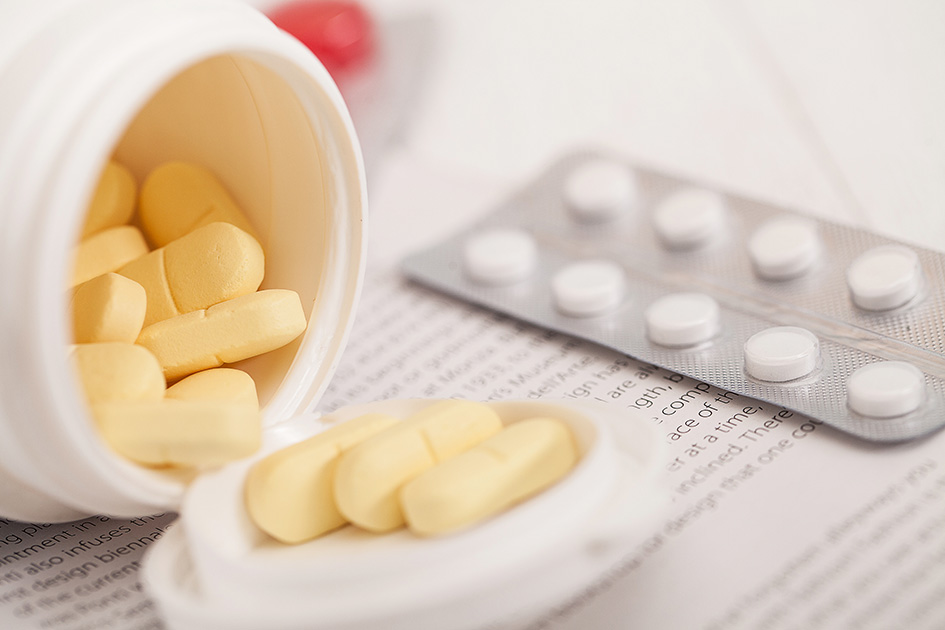Many doctors prescribe medication to help their patients combat pain as part of pain management. These medicines are more potent and often a controlled substances. Because of their potency, they are very effective at easing pain, but they are often misused, which could lead to dependence or substance use disorder.
In 2020, over 91,000 people died from overdoses, including prescription drug-related fatalities using opioid medication. As of 2022, 16 million people over 12 abuse prescription medicines annually.
Prescription drug abuse in the United States is not limited to opioid pain medication, but other painkillers, stimulants, sedatives, and CNS depressants have abuse potential. Because of an increased risk of misusing prescription medicines, statistics indicate that two million people have developed mild to severe substance use disorder.
What Is Prescription Drug Abuse?
According to the National Institute on Drug Abuse, abuse occurs when a person uses medicine differently than what was intended by the prescriber or to experience or feel the effects of the drug. Substituting or increasing the prescribed medication dosage to achieve an altered mental state (i.e., "getting high") is one example of drug abuse.
The Institute for Safe Medication Practices lists the following as examples of prescription drug misuse: taking the wrong dosage, taking a dose at the wrong time, forgetting to take it on schedule, or discontinuing medication too soon.
The FDA defines misuse of prescription drugs as any use of a medicine other than under a doctor's order, but the user's intention is not to "get high." For instance, If a person takes a sleeping pill and still has trouble falling asleep an hour later, they may take a second dose, hoping that that will do the trick.
Another example is if someone offers their painkillers to a friend who is also suffering from experiences of pain. The Food and Drug Administration (FDA) classifies it as drug misuse since the individual is attempting to treat oneself but is not following their doctors' recommendations.
The best way to prevent abuse is to ensure you are taking prescription drugs as prescribed by a healthcare professional or directed by a pharmacist. Medications can have serious side effects and even be fatal if mishandled. You should not take your prescription drugs with other people, as this can lead to serious health issues if the person should have adverse effects. Taking higher doses or increasing the frequency can have negative consequences, including overdose deaths, physical dependence and addiction, and debilitating conditions that will negatively impact your life and ability to function.
Prescription Drug Types
Several kinds of prescription drugs are commonly more misused than others. Widely abused medications include opioids for pain relief, central nervous system depressants for anxiety and sleep problems, and stimulants for ADHD. If prescribed any of these drugs, you should be informed that they are intended to treat a specific condition and not meant for misuse or nonmedical purposes.
Opioids
Opioids are a type of prescription medication typically used to treat pain. They work by binding to opioid receptors in the brain and spinal cord, reducing pain perception. Opioid painkillers can be either natural or synthetic, often prescribed as pills, patches, or injections. There are many opioid prescription medications, each with its unique benefits and risks. The most common types include morphine, oxycodone, hydrocodone, and codeine. Opioids are generally considered safe when used as directed by a doctor, but they can be addictive and potentially harmful when misused and result in opioid overdose in high doses.
Stimulants
People use stimulant prescription medications are drugs that are used to treat conditions like ADHD and narcolepsy. They work by increasing levels of dopamine and norepinephrine in the brain, which can improve focus and attention. Common stimulants include methylphenidate (Ritalin), dextroamphetamine (Adderall), and lisdexamfetamine (Vyvanse). People may use stimulants to treat their ADHD symptoms and be alert, but they can also have side effects like insomnia, anxiety, and appetite suppression.
CNS Depressants
CNS Depressant prescription medications act on the central nervous system (CNS) to produce a calming or sedating outcome. They enhance the neurotransmitter GABA's effects in the brain and are typically used to treat anxiety, insomnia, and seizures. Common examples of CNS Depressants include benzodiazepines (e.g., Xanax, Valium), barbiturates (e.g., Amytal, Seconal), and sleep medications (e.g., Ambien, Lunesta). CNS Depressants are typically only prescribed for short-term use due to the risks of addiction and overdose. If you are taking CNS depressants, it is crucial to follow your doctor's instructions carefully and not exceed the recommended dosage.
Prescription Drug Abuse Risk Factors
There are several risk factors associated with prescription drug abuse. One of the most significant risk factors is the availability of these drugs. When patients have easy access to their prescription medications, they are more likely to abuse them.
Another important risk factor is a history of substance abuse. People who have previously abused alcohol or other drugs are more likely to misuse prescription medications. Additionally, people with mental health disorders are at increased risk for prescription drug abuse.
Several environmental factors can contribute to prescription drug abuse. For example, people who live in chaotic or stressful environments are more likely to turn to drugs to cope with their stress. Additionally, people with significant social pressure to use drugs are more likely to abuse them.
What Are the Dangers of Abusing Medicines?
Opioids are an effective and safe method of treating chronic pain. However, abusers risk fatal respiratory depression and coma from a single high dosage. Addiction and physical reliance on opioids may result from their regular use or misuse. Withdrawal symptoms might be similar in both cases, including agitation, muscle and bone pain, sleeplessness, diarrhea, vomiting, and chills accompanied by goosebumps.
Benzodiazepines and barbiturates have an abuse risk and should only be used as recommended. A person taking a CNS depressant for the first time would likely feel tired and awkward during the first few days. Still, tolerance and familiarity with the medication gradually cause the unwanted effects to disappear. Long-term usage of these drugs may need higher dosages to have the same therapeutic effect. Physical dependency and withdrawal symptoms may develop with prolonged usage, even when taken the prescribed way. It can be complicated to treat if the user suddenly attempts to cut down or discontinue their use.
Stimulants have the risk potential to cause dependence and addiction in the same way that other substances of abuse do. Quitting stimulant medications might cause weariness, sadness, and sleep disruptions. Some stimulants may cause paranoia, aggression, and even psychosis if used excessively and repeatedly. High dosages of stimulants may cause dangerously high body temperatures and heart rates. Heart failure and convulsions are other possibilities.
What Are the Common Signs of Prescription Drug Abuse?
The signs and symptoms of abuse and addiction can vary and depend on various factors. These factors may include the type of drug being taken, the frequency and dosage of the medicine, and how it affects people differently. However, the physical, behavioral, and psychological symptoms will typically include some or all of the following:
Behavioral Symptoms:
- Taking more drugs than prescribed and finding it hard to stop taking them
- Poor attendance or performance at work
- Becoming socially withdrawn
- Losing interest in hobbies and activities that were once enjoyable
- Lying and being dishonest about the extent of drug use
- Using painkillers in situations where it is dangerous, such as driving or operating machinery
- Using painkillers even after the legitimate symptoms they were originally used for have subsided
- Stealing or borrowing prescription painkillers or other medications
- Visiting many doctors in an attempt to acquire multiple prescriptions
- Ordering prescriptions over the Internet
- Evidence of drug paraphernalia, such as needles and syringes used to inject the drugs.
- Lack of interest in personal hygiene and grooming
- Breakdowns in relationships
- Financial problems
- Problems with law enforcement leading to arrest and imprisonment
Physical Symptoms:
- Dilated pupils
- Problems with coordination
- Excessive sweating
- Insomnia and irregular sleep patterns
- Itchiness
Cognitive Symptoms:
- Poor judgment
- Struggling to concentrate or focus
- Dizziness, confusion, or disorientation
- Delusions and hallucinations
Psychological Symptoms:
- Mood swings
- Irritability
- Anxiety
- Depression
Prescription Drug Detox: The First Step Towards Recovery
The first step towards recovery and rehabilitation is the prescription drug detox. This process is designed to remove all toxins that prescription drugs leave behind in the system. Our medically-supervised drug detox program encompasses several therapies and medicines that help to ease discomfort and withdrawal symptoms assisting patients in starting their road to recovery.
At Wish Recovery, we offer prescription drug detox intravenous (IV) therapy, a quick and effective way to replace toxins with essential nutrients such as vitamins and minerals, amino acids, and oxygen. Following detox, patients continue with substance abuse and mental health services in rehabilitation, including individual, group, and family therapy, cognitive behavioral therapy and other behavioral therapies, alternative and complementary modalities, and more.
The Importance of a Medically Supervised Detox
Undergoing prescription drug detoxification should always be carried out under medical supervision. Detoxification is not without its risks, but undergoing withdrawal under the careful watch of a dedicated medical support team will help to keep these risks at an absolute minimum.
At Wish Recovery, our luxury rehab center in Los Angeles offers prescription drug rehabilitation and personalized treatment for addiction in a safe, supportive and serene environment. No matter what the stage of addiction or how many times recovery has been attempted, we tailor our services and treatments to suit the unique needs of every individual.


